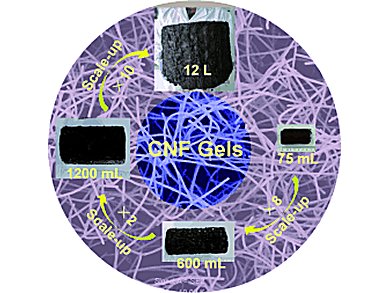Replacing the liquid solvent in hydrogels or other wet gels by air without collapsing the network structure can lead to a new type of porous materials, namely, aerogels. Particularly, 3D nanoscale networks with open pores in the gels allow access and fast diffusion of ions and molecules. Thus hydro-/aerogels have exhibited excellent performance as super adsorbents, electrode materials for batteries and supercapacitors, catalyst supports, and chemical and biological sensors.
Shu-Hong Yu and colleagues, University of Science and Technology of China, Hefei, report the fabrication of a new type of monolithic hydro-/aerogels consisting of highly uniform carbonaceous nanofibers (CNFs) through a simple template-directed hydrothermal carbonization process. The CNF gels exhibit extraordinary compressibility, in marked contrast to the brittle nature of traditional low-density aerogels.
The versatility of the synthesis allows to easily achieve large-scale synthesis (12 L) and control the diameter of the CNFs as well as the porosity and mechanical strength of the gels. The high surface reactivity of the CNFs and extra-high porosity and robust mechanical properties of the gels, gives the gels great potential for simple removal of dye pollutants, as selective adsorbents for oil-spill cleanup, and as versatile 3D templates for creating functional composite gels.
Moreover, by post-carbonization treatment of the as-prepared CNF samples at high temperature, highly conductive CNF aerogels with high surface area are obtained. They should find applications in a wide range of other fields, including conductive composites, catalyst supports, and 3D electrode materials for lithium-ion batteries and supercapacitors.
- Macroscopic-Scale Template Synthesis of Robust Carbonaceous Nanofiber Hydrogels and Aerogels and Their Applications,
Hai-Wei Liang, Qing-Fang Guan, Li-Feng Chen, Zhu Zhu, Wen-Jun Zhang, Shu-Hong Yu,
Angew. Chem. Int. Ed. 2012, 51.
DOI: 10.1002/anie.201200710




